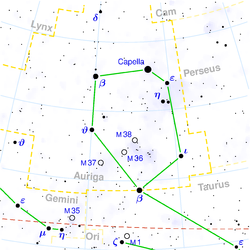- Theta Aurigae
-
θ Aurigae Observation data
Epoch J2000 Equinox J2000Constellation Auriga Right ascension 05h 59m 43.269s Declination +37° 12′ 45.307″ Apparent magnitude (V) 2.62 Characteristics Spectral type A0sp... U−B color index -0.18 B−V color index -0.08 R−I color index -0.06 Variable type Alpha2 CVn variable Astrometry Radial velocity (Rv) 29.5 km/s Proper motion (μ) RA: 42.09 mas/yr
Dec.: -73.61 mas/yrParallax (π) 18.83 ± 0.81 mas Distance 173 ± 7 ly
(53 ± 2 pc)Absolute magnitude (MV) 2.54 Details Mass 3.1 M☉ Radius 2.1 R☉ Luminosity 40 L☉ Temperature 7,500–10,000 K Rotational velocity (v sin i) 49 Km/s km/s Other designations Database references SIMBAD data Data sources: Hipparcos Catalogue,
CCDM (2002),
Bright Star Catalogue (5th rev. ed.)Database references SIMBAD data Theta Aurigae (θ Aur, θ Aurigae) is a binary star[citation needed] in the constellation Auriga. It is approximately 173 light-years from Earth. Rarely used proper names for this star include Bogardus and Mahasim, the latter from the Arabic المِعْصَم al-micşam "wrist" (of the charioteer), which was also used for Eta Aurigae.[1]
The primary, θ Aurigae A, is a white A-type main sequence dwarf with an apparent magnitude of +2.7. Its companion, θ Aurigae B, is a yellow G-type main sequence dwarf with an apparent magnitude of +7.2. The two stars are separated by 3.5 arcseconds. A third star, the 11th magnitude θ Aurigae C, is 49 arcseconds away, and is an optical companion.
The mean combined apparent magnitude of the system is +2.65 but the primary is an Alpha2 Canum Venaticorum type variable star so the system's brightness varies from magnitude +2.62 to +2.70 with a period of 1.37 days.
It is known as 五車四 (the Fourth Star of the Five Chariots) in Chinese.
References
Bayer Flamsteed 2 • 3 (ι, Hassaleh) • 4 (ω) • 5 • 6 • 7 (ε, Almaaz) • 8 (ζ, Sadatoni) • 9 • 10 (η) • 11 (μ) • 12 • 13 (α, Capella) • 14 • 15 (λ) • 16 • 17 • 18 • 19 • 20 (ρ) • 21 (σ) • 22 • 24 (φ) • 25 (χ) • 26 • 27 (ο) • 28 • 29 (τ) • 30 (ξ) • 31 (υ) • 32 (ν) • 33 (δ) • 34 (β, Menkalinan) • 35 (π) • 36 • 37 (θ) • 38 • 39 • 40 • 41 • 42 • 43 • 44 (κ) • 45 • 46 (ψ¹) • 47 • 48 • 49 • 50 (ψ²) • 51 • 52 (ψ³) • 53 • 54 • 55 (ψ4) • 56 (ψ⁵) • 57 (ψ6) • 58 (ψ7) • 59 • 60 • 61 (ψ8) • 62 • 63 • 64 • 65 • 66Nearby QY • UGPS J0521+3640Categories:- Henry Draper Catalogue objects
- HIP objects
- Bayer objects
- Auriga constellation
- Alpha2 Canum Venaticorum variables
- Binary stars
- Triple stars
- A-type main sequence stars
- G-type main sequence stars
- Stars with proper names
- Multiple star stubs
- Variable star stubs
Wikimedia Foundation. 2010.

